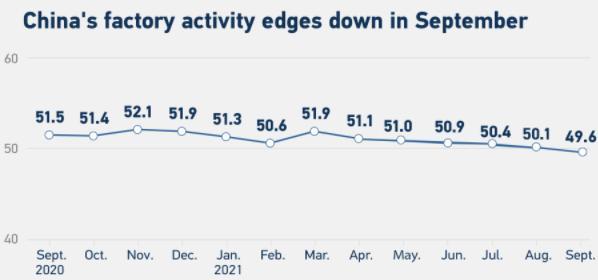Impact of China’s Power Crisis on Manufacturing Activity
EVENT BRIEF
- The power crisis in China has worsened in recent weeks with reports in the first week of October stating that almost two-third of China is facing power rationing (see map below). Cases of city-wide blackouts have also been reported. The problem is most pronounced in Northeastern, Eastern and Southwestern China.

Source: Cementren and BJX/Bloomberg
- Sources indicate that the power rationing and blackouts are indicators that China’s power crisis has exacerbated. The power crisis has found mention in reports through most of CY 2021. Some of the factors responsible for it include:
- China’s push for carbon neutrality to gain favour globally. This led to a reduction in coal production (~55-60% of China’s power is generated from coal). The drop in coal production was further exacerbated by extreme weather events such as floods and mining accidents.
- High and increasing power demand since mid-2020 (when China emerged from the COVID-19 pandemic). The demand further increased during winter 2020-2021 due to harsher than average weather.
- High domestic and global coal prices, which eroded profit margins of power generation companies and led to production curbs (also impacted by green goals). The China-Australia trade war also impacted imports.
- China’s green goals and power crunch was already having an impact on manufacturing activity since at least May, 2021. Recent developments indicate a further drop in manufacturing activity.
Impact on manufacturing
- Sources have reported that power firms have been asking industries in places in and around Shanghai, Guangzhou and Shantou to not operate during peak hours since May, 2021.
- Additionally, local governments in all provinces have been pushing factories to minimise power consumption and even shut down for a few days every week to meet their carbon emission targets. These targets have been placed by the centre.
- In August 2021, the National Development and Reform Commission, a central planning agency, criticized 20 provincial governments over their failure to meet carbon emission targets for the first half CY 2021.
- In recent weeks, reports indicate that several energy-intensive industries like aluminium, cement, steel, chip manufacturing and electronics have suspended operations due to sustained power cuts.
- Power cuts have also led to suspension of work in factories in manufacturing and industrial hubs like Jiangsu, Anhui, Zhejiang, Guangdong and Suzhou.
- Official data showed that Chinese factory activity in September 2021 contracted to the lowest since February 2020 (see graph below). The drop in manufacturing is also a reason cited by rating agencies for a downward revision in China’s 2021 GDP forecast. Some recent revisions are as follows:
- IMF: 8% from 8.4%
- Nomura: 7.7% from 8.2%
- Goldman Sachs: 7.8% from 8.2%

Indicator used in above graph is the National Purchasing Managers’ Index (PMI)
Source: National Bureau of Statistics (People’s Republic of China)/CGTN
Mitigation measures and possible timelines
- The Chinese government has tried to ease the power crisis by increasing domestic coal production, but flooding of mines continues to affect production. Additionally, reports indicate that China is easing its unofficial ban on Australian coal imports.
- From October 15 onwards, China will allow power distribution companies to sell electricity at market rates (as opposed to fixed rates) to industrial and commercial consumers to incentivise power generation.
- However, China has stuck to its carbon emission control commitments on global forums as early as the first week of October and indicated that pollution curbs would stay.
- Sources have estimated that the power crisis is likely to last into at least Q1 of CY 2022 (end of winter season). Additionally, the crisis may further exacerbate if China experiences an extreme winter. Some sources have stated that the crisis may continue till coal prices remain high.
ASSESSMENT
- Official data confirms reports of a drop in manufacturing activity in China due to the power crisis and carbon emission controls. Most regions housing key manufacturers have been affected.
- Manufacturers are likely to be witnessing a drop in manufacturing activity and in some cases may have also suspended factory operations.
- This is likely to lead to delays in deliveries to customers. It may also potentially impact the ability of suppliers to fulfill contractual obligations.
- Additionally, it may lead to an increase in product prices in the near future.
8 Comment(s)
Related Posts
No related post found.


Davidmah
2 years agobet cha.pa
10 months agoapp 1xbet
10 months ago20bet registration
10 months agomelbetbdofficial
10 months agoWilliamknord
9 months agoRickeyOnera
9 months agoElliottrarie
8 months ago